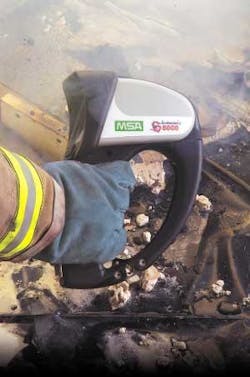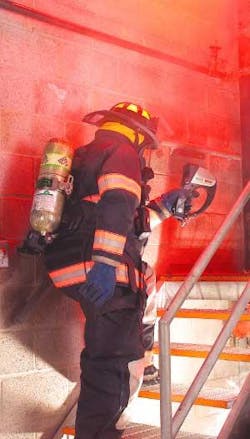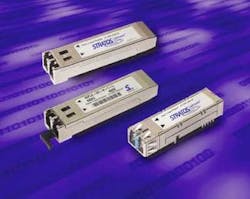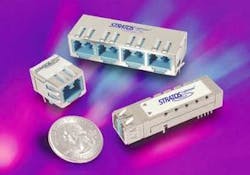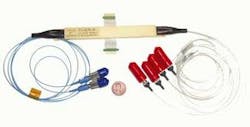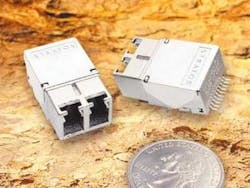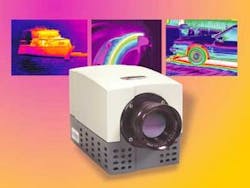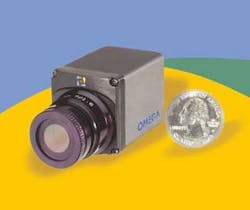The 24/7 resource for the defense community
By J.R. Wilson
In 21st century military programs, the huge up-front nonrecurring developmental budget has long been extinct. Also extinct, however, is the expectation of paying higher prices in the future to upgrade systems technologies. Both were felled by the U.S. Department of Defense's (DOD's) elimination of MILSPEC standards and near-total embrace of commercial off-the-shelf (COTS) components, which in turn led contractors to open architecture designs.
The intent was to free future systems of obsolescence and diminishing manufacturing sources (DMS) — creating a military that no longer operates in a technology time warp generations behind a civilian world of ever-faster computers, cheaper communications, and increasing capability. A good benchmark for this may be optoelectronics, which only in recent years has begun to establish itself not only in the broad commercial world, but also in the military, for a vast array of enhanced performance and capabilities.
null
null
The question is, how successful is the military's effort to go to open architectures to close the technology gap between leading-edge commercial optoelectronics and what designers are adapting to military applications?
The answer may be indicative of future military technology in general; in some cases the Pentagon actually regains its old status as technology driver, while in others the Pentagon is current or a few steps behind the cutting edge. In both cases the matter is entirely a matter of choice.
While multipage military specifications no longer lock contractors into rigid definitions of what optoelectronic and electronic components they can use, the requirements of military use remain valid, and in fact far exceed commercial needs in areas such as temperature range, shock and vibration, and radiation resistance. To handle the harsh environment of military operations, many COTS optoelectronic and electronic components will continue to need an intermediary to ruggedize, militarize, containerize, or just screen them to acceptable levels.
Commercial upscreening
While state-of-the-art commercial optoelectronics technology is central to military telecommunications equipment, designers also often require noncommercial hermetically sealed, multichannel transceivers in unique, small packages.
Golden Shu is chief optical engineer at Teledyne Microelectronic Technologies in Los Angeles. "Commercial fiber only goes to 85 degrees Celsius, so we screen it to a higher level," Shu explains. "And we have found the products of different companies, even though they are equal at that commercially required level are different when we test to extended-range requirements. The commercial manufacturers won't screen to those levels themselves, so we have to."
That also is true at the other end of the scale where commercial specs run –20°C to 85°C but military customers often need –45°C to 90°C, Shu says. "It used to be 125°C, but the military now recognizes those kinds of stringent requirements just aren't realistic anymore. You can get hand-screened devices at those upper levels, but those are extremely expensive."
The need to determine whether a COTS product can reliably exceed the commercial specifications to which the manufacturer does test — or find ways to package it to meet military requirements if not — has been an increasingly important niche business as first the personal computer and more recently cell phone and other mass market electronics have replaced the military as technology drivers.
If military contractors could buy those parts in the commercial optoelectronics market, "they wouldn't need us," agrees Al Gaertner, Teledyne optical products line manager. "The government and military primes are encouraging us to find other components that meet those harsher requirements, but that also decrease costs and increase performance. And they want to do technology refreshes over a 20-year-plus lifespan. You can only do so much with assembly and test, which is why you need commercial components that will drop in without changing the design or form factor."
However, he adds, there are still times when the military need exceeds commercial requirements in performance, size, or other factors beyond environmental. If the need is great enough, the Pentagon reclaims its old role of technology driver.
"That is a rare occurrence," Gaertner admits. "But when we do push the technology based on a unique military requirement, commercial manufacturers are not resisting because it sometimes gives them other ways of doing things, such as the high degree of coupling capability we need in a very small form factor. That gives them another new widget to put in their catalog to offer their commercial customers."
Until recently, the massive size of commercial telecommunications and other electronics markets had reduced military procurements to insignificance, even as Pentagon research and development budgets also shrank. But another new technology spurred by civilian and military efforts has helped reduce the time and cost of developing new or unique concepts. Computer modeling and virtual prototyping have allowed systems designers to predict performance and utility, and examine new applications quickly and inexpensively. This has proven especially valuable in the development of optoelectronics.
Key to optoelectronics
"The key to optoelectronics is the optical coupling," Gaertner says. "Unless you do all your modeling up front and make sure the components have everything designed in from the beginning, you'll never achieve your goal. In the old days, you built a prototype, you did breadboards and brassboards, and all that took years. Now we can go from zero to an operational unit in six months because we fix all the problems in the modeling. That also identifies all the risks and enables you to do risk mitigation, including screening all those commercial parts."
Within the broad range of optoelectronics technology, there is at least one area — infrared (IR) technology — in which the military has been the prime driver from the beginning, says Tim Fitzgibbons, president of Indigo Systems Corp. in Goleta, Calif. However, he adds, DOD now stands at a decision point on whether to join the rapidly evolving commercial trend — and perhaps help steer it — or follow the old path of unique development that historically has led to obsolescence and DMS.
"In infrared optoelectronics technology, the military has been the main user, which started just prior to World War II in Germany. For many years, there was very little commercial application, so we are coming from a position of the military basically owning the technology and spending tremendous amounts of money to advance it," he says.
null
null
"Only in the past 15 years have commercial applications become so compelling that a lot of activity has gone into reducing the size, weight, shape, and cost of systems to make them available to commercial users," Fitzgibbons says. "If those systems are configured for dual use, DOD gets a very large bang for the buck. But to make that happen, we have to come up with an architecture that allows us to move between the two camps with something that is essentially the same, although it may have superior specs for the military compared to commercial."
Given that background and continuing heavy government sponsorship of industry research and development, the military continues to have the highest level of IR technology, unlike what has happened in the microprocessor arena. But IR evolution has now reached a familiar point — commercial users who order millions of units and the government designers who want low price but are willing only to place orders in the hundreds. Fitzgibbons says no company can afford to do that unless it can leverage the economies of scale from its commercial sales and meet the military requirement with, at most, only minor tweaks to the technology. Even then, the government will need to help cover non-recurring engineering (NRE) costs.
"That is the essence of the Rumsfeld transformation, as we see it, in that the platforms we have can be quickly adapted to military missions and we can offer prices based on the commercial scale of our business, asking for only small quantities of money from the government to advance the technology along with our own internal research and development funds," he says. "So the government gets the best of all possible worlds."
Indigo, whose merger with FLIR Systems in Portland, Ore., was expected by early January, has seen an interesting military/commercial interaction at the high and low ends of the company's IR camera line. The high-end devices were developed for the commercial research and development market to observe high-speed events in tire manufacturing, for example. The military found that same high-acuity, high-resolution capability met their requirements for standoff weapons systems.
In one such example, Indigo was developing a high-end camera for an industrial application when they received NRE funding from Northrop Grumman Corp. in Los Angeles for some specific feature modifications. The result was a special version of the large format indium antimonide (InSb) Phoenix camera used in the LITENING AT and ER aircraft targeting pods.
null
"We were able to turn into a military star in less than a year," Fitzgibbons says. "And it now also is a very successful commercial product, mostly for research and development applications in the area of phenomenology for people who want to watch fabrication processes, such as monitoring moisture content in paper production. That also works in reverse — if the military is interested in a specific high-end camera, we might only be able to build it if we could take a reduced version to the commercial world, which in most cases is perfectly agreeable."
At the other end of the product line is a miniature, ultra-lightweight, ultra-low-powered camera based on uncooled microbolometer technology the government first began sponsoring in the 1980s. But when the first practical devices began to appear a decade later, it was the commercial market that began designing products around them.
null
Mine Safety Appliances (MSA) in Pittsburgh incorporates Indigo's long wavelength miniature uncooled IR camera into a rugged, handheld device to help firefighters see through thick smoke, something Fitzgibbons says also has potential military applications. Indigo also recently signed an agreement with an unidentified German car manufacturer to use the same Omega core in an extended night-vision system for 2006-model luxury cars.
"All three of those applications could use a very similar camera; it has an open architecture and is software configurable, so the time to morph it to any anticipated application — including the military — is very short," he says. "There is a huge potential demand for those in the commercial world that probably will ramp up much more quickly than a Pentagon program. After all, there are four million firefighters worldwide — more than a quarter of those in the U.S. And that is tiny compared to the automotive potential. The German order alone will dwarf DOD needs for some time to come."
High-frame-rate cooled thermal InSb cameras frequently are for long-range strategic detection applications, while smaller, less expensive uncooled micro-bolometer-based cameras, typically limited to 30-Hz video rates, are generally for short-range tactical sensing. Cooled cameras convert IR photons directly into an electrical charge, which electronically assembles into a picture. Uncooled cameras convert IR photons into minute quantities of heat, which change the electrical characteristics of an absorber material to produce a picture.
Fitzgibbons says industrial requirements that the IR segment already meets address DOD environmental concerns. Still, even without formal military specifications, government customers tend to demand more than they need or can afford. That is a major concern, given plans to put such sensors on every soldier and platform and even seed the battlefield with them to use sensors to identify passing targets for precision-guided munitions instead of laying minefields.
"The government wants these things everywhere, but the reflexive approach to go their own way still seems to be a powerful force," he says. "The military has always had a tendency to overspec what they actually need, demanding smaller pixels and higher resolution even on close-combat weapons. That is another leap over what firemen or cars are using, but all that does is push the fielding out another five or seven years when they could have it now and in abundant quantities."
Developmental false start
Optoelectronics also demonstrates another scenario, where the explosion of commercial growth created technology developments that exceeded need and the ability of a then-stagnating economy to support the cost. As Duane Teachout, advanced products applications manager at Stratos Lightwave in Chicago notes, it sometimes proved more cost effective to use an incremental approach in such instances, such as moving to all-optical switching.
"In time, some of the more exotic technologies will come back, because they are good answers, but in reality, we got a bit ahead of ourselves," he says, although considerable progress still has been made. "Gigabit Ethernet and Fibre Channel are getting a lot of use and what was a new technology five years ago is now mainstream and very reliable. And that's where the bulk of the increased infrastructure lies, where the proven technology is in the commercial space; 10-Gig is coming on the scene, but is still out there a little ways.
"On the military side, they have taken systems such as Fibre Channel and installed them on very nontraditional platforms and are using Ethernet for a host of applications, both traditional architectures as well as optimized, platform-specific applications. They use it because it is fast, proven, and by now inexpensive compared to a lot of other things. There also are a lot of proprietary links in the military space that have leveraged developments in the commercial segment. They are not running a standard protocol, but the physical layer still looks like a standard Gigabit or Fibre Channel or InfiniBand you would find in the commercial space."
One example of how well the military is keeping pace is the current move to 2.5 gigabit-per-second per channel (OC-48) long-haul backbone fiber connections, which have been the commercial standard since the late 1990s. The move to the next generation — OC0192 at 10 gigabits per second — which is available in the commercial marketplace but has not been widely adopted due to high cost and limited operational demand, may bring the two closer to parity, as Shu says the military would like to make that transition by mid-decade. Neither market, however, is expected to push anytime soon for the next stage beyond that — OC-768 at 40 gigabits per second.
"Our military customers want to go to OC-192 sooner rather than later so they don't have that big lag," Gaertner says. "So the time gap is improving. Will it ever be completely equal to commercial? Probably not, because the military wants to wait until commercial demand is up and prices come down. They may make an exception if they have a specific application they need right away, but generally they will wait a while, but not as long as it used to be."
While the two markets are becoming closer in technology use, Teachout says even a fundamentally sound commercial Gigabit Ethernet design still requires some optimization for military and aerospace applications. Because most military systems are closed, without the wide range of user interoperability found in commercial systems, that optimization may lead to something that is a step above a standard part.
"While optoelectronic parts are more robust today than, say, five years ago, there is still the need to meet customer requirements, such as humidity levels or temperature ranges in military applications that are not typically found in the commercial world," he says, adding that the key to any vendor making that transition successfully is finding ways to control the cost of that extra step while ensuring quality.
In some instances, an intermediary like Teledyne handles that step; in others, original suppliers like Stratos Lightwave may seek to accommodate commercial and military requirements internally.
"The commercial world is driven by pricing and multiple sourcing — commodity parts. Unfortunately, the commodity definition they are driving for is not one that satisfies the requirements of the military market," Teachout says.
"We will define, design, develop, manufacture, and test all our parts to the specified power levels, data rates and protocols and environmental requirements. Instead of looking at technology moving up a curve over program life, we're seeing a wide adaptation of technology into a host of different systems. So you may have a 100-megabit Ethernet LAN on the battlefield, a completely fiber-based system, a 2.5-gigabit sensor application, on a missile and so on."
Toomas Kilm, executive vice president for marketing and business development at CeLight in Silver Spring, Md., notes the military plans to connect more than 100 key locations around the world with state-of-the-art dense-wavelength-division- multiplexing optical-fiber circuits. The goal is to provide transmission as fast as 10 gigabits per second to accommodate far larger volumes of computer data, video images, and sensor data than previously possible.
null
"In that sense, they are in step with the latest commercial technology and, beyond security — where they will use COMSEC (communications security) encryption — there are no extra requirements that had to be put in for that network," he says.
By extending that requirement to ground-to-air and air-to-air communications, however, the military is advancing to where commercial technology has few deployed systems.
Military communications
"There are requirements in that environment that go beyond what commercial optical systems would provide," Kilm says. "For one, you have to go through atmosphere rather than fiber, which in a military situation may include smoke or other obscurances to line-of-sight between sender and receiver.
"What the Air Force is actually asking for in their family of terminals concept for lasercom, which encompasses both air-to-air and air-to-satellite for unclassified information, is implementation of a JTRS-like (Joint Tactical Radio System) capability. They want the architecture of the terminal to be modular — front-end interfaces with the baseband signal, whether RF communications channels or sensors. The concept is to mix and match among different vendors to get state- of-the-art technology, so if microprocessors are faster in two years, you can swap those out without impacting the rest of the system."
null
null
Such programmable modules within a JTRS-type optical terminal will enable not only the insertion of increased capacity as higher speeds and advanced waveforms become available, but also interoperability with current and future generations of equipment.
"The military is driving this vision to achieve state-of-the-art solutions based on the JTRS approach because the environment in which they are working is more stringent than found in the traditional commercial fiber world. The question is whether industry can meet that demand," Kilm says. "Right now, given the weak state of the commercial market, the military probably will drive the development of that technology, with the commercial world leveraging it down the road."
CeLight's response to an optical-world JTRS lies with the company's VectorWAVE programmable modular digital architecture, which Kilm says can handle commercial-style on/off keying and phase-shift keying, such as differential binary (DPSK) or quadrature (QPSK), as well as more-advanced modulation schemes. While most commercial modulators only handle one approach — primarily on/off — the ability to switch from one modulation or security scheme or speed to another without worrying about incompatibilities also means future technologies can be incorporated through software reconfigurations rather than hardware changes.
"For air-to-air applications, having an open architecture drives industrial competition, rather than one company doing everything, so the military can take the best-of-breed in each technology and fit them together in a way that will best serve the need," Kilm says. "And for industry, if you're going to invest money in building a product that will have applicability back into the commercial market — as well as homeland security — you have a much more positive business case and are more likely to proceed.
"Once the military has some of these advanced lasercom applications that are applicable to ground-to-air and air-to-satellite, that will accelerate migration back into the commercial market for new services that could be provided for business, initially, but eventually to residential. The ability to beam large quantities of video around the world in a cost-effective manner with lots of bandwidth would provide for customization of a lot of new applications."
Teachout says commercial development has stalled for the moment because no popular "killer application" is demanding dramatically high bandwidth and there is no clear indication of what the consumer base is looking for. The situation is reversed for the military, however, whose appetite for greater speed and accuracy appears insatiable."A lot of things have happened in the last five to eight years that are factors in where we currently find ourselves, in both the commercial and military worlds," Teachout continues. "Most of what the military is doing in advanced applications is a far cry from what is commonly being investigated in the commercial space, so you still have some trailing of cutting edge technology in deployable systems, but an actual lead in future systems. Over time, some of those unique, far-reaching military elements may become more mainstream."
Click here to view Company Information. [pdf size=68Kb]
